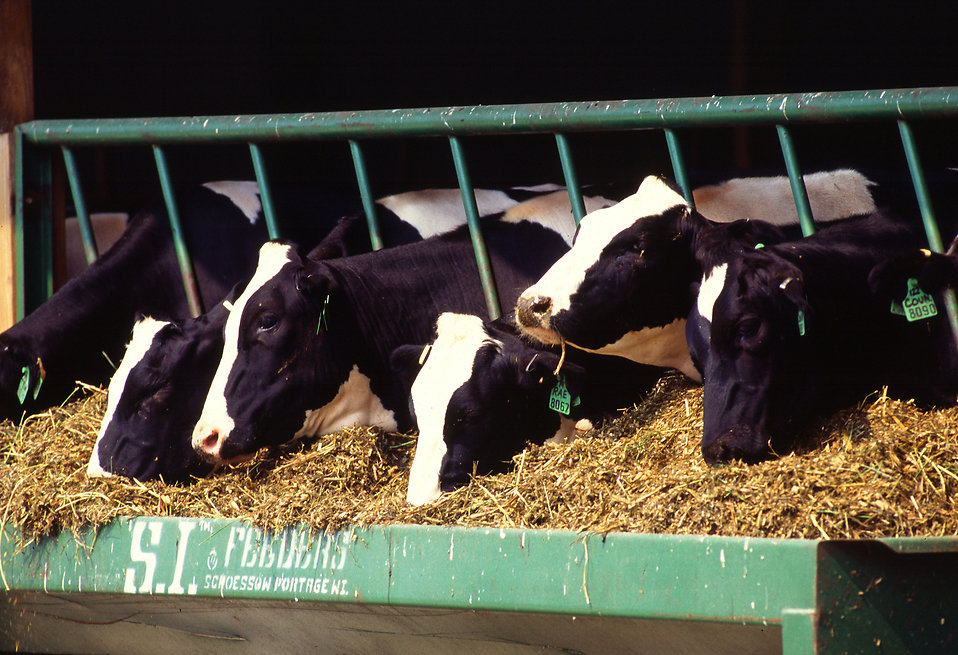Although some dairies have their own unique methods of milk production, most dairies in the United States follow the eight-step process seen below.
The top five milk producing states in 2019 were California, Idaho, New York, Texas, and Wisconsin. These states produced over 50% of the country’s milk. In 2019, 218,382 million pounds of milk were produced in the US.
Step 1: Rearing

Dairy cows typically spend their days eating, sleeping, and ruminating (chewing their cud). Cows in some dairy farms wander around and eat fresh grass (grazing). In other farms, they are fed grain, hay, or silage (conserved forage) and remain all day in close quarters known as confined animal feeding operations (CAFOs), some of which house thousands of animals.
Many large dairy farms utilize growth hormones and antibiotics during the rearing process to artificially increase a cow’s milk production and to decrease the spread of infectious diseases among their cows.
Most US dairy cows are Holsteins (the black and white cows seen in the photo below), though Jersey cows (the brown cows in the photo above) and other crossbreeds are also used. In 2019, there were 9,336 milk cows in the United States. Each cow produced an average of 23,391 pounds of milk.

Step 2: Harvesting

Hand-Milking
A cow is ready to be milked when her udder is full. The farmer has some flexibility when making a schedule of cow milking times. Usually, cows are milked in the early morning and again in the late afternoon. It is possible to milk a cow by hand. However, milking a whole herd of cows twice a day in this manner would take a great deal of time and energy. Before the invention of milking machines, people milked their dairy cows by hand by squeezing gently on the cow’s teats using the thumb and forefinger. Some people continue to milk by hand.
Machine-Milking
Cows are normally milked at least twice a day. Milking time takes about five minutes per cow depending on the type of machine and the amount of milk the cow is producing. Most dairies have enough machines to milk more than 20 cows at one time. Milking machines mimic the action of a young calf by creating a pulsating vacuum around the teat, which causes the milk to be released from the udder.

Step 3: Storing

Milk storage vats or silos are refrigerated and come in various shapes and sizes. Milk is usually stored on the farm at 39 degrees Fahrenheit, or colder, for no more than 48 hours. Vats and silos are agitated to make sure that the entire volume remains cold and that the milkfat does not separate from the milk. After milk has been collected, storage vats and stainless steel pipes are thoroughly cleaned before the farmer milks again.
Step 4: Transportation

Milk is collected from the farm every 24 or 48 hours. The tankers that are used have special stainless steel bodies which are heavily insulated to keep the milk cold during transportation to the processing factory. Milk tanker drivers are accredited milk graders, qualified to evaluate the milk prior to collection. Tanker drivers grade and if necessary reject milk based on temperature, sight, and smell. A representative sample is collected from each farm pickup prior to being pumped onto the tanker. After collection, milk is transported to factory sites and stored in refrigerated silos before processing.
Step 5: Lab Testing

Samples of milk are taken from farm vats prior to collection and from the bulk milk tanker upon arrival at the factory. Samples from the bulk milk tanker are tested for antibiotics and temperature before the milk enters the factory processing area. Farm milk samples are tested for milkfat, protein, bulk milk cell count and bacteria count. If milk does not meet quality standards it is rejected. Most farmers are paid on the quality and composition of their milk.
Step 6: Processing

Whole milk, once approved for use, is pumped into storage silos where it undergoes pasteurization, homogenization, separation and further processing.
Pasteurization:
Every particle of milk is heated to a specific temperature for a specified period of time and cooling it again without allowing recontamination.
Homogenization:
Raw milk is pushed through an atomizer to form tiny particles so that the fat is dispersed evenly throughout the milk, stopping the fat from floating to the top of the container.
Separation:
The milk is spun through a centrifuge to separate the cream from the milk. After separation, the cream and remaining milk are remixed to provide the desired fat content for the different types of milk being produced.
For whole milk the cream is reintroduced until the fat content reaches 3.25%. For low fat milk the fat content is 1%. For skim milk (sometimes called nonfat milk) the fat content is .05%.
Further Processing:
This step may involve micro-filtration, increasing the storage life by ultra high temperature (UHT) treatment, and mixing or culturing milk for flavored and yogurt products.
Step 7: Packaging

Now the milk is ready to be packaged for delivery to the stores. The milk travels through pipes to the automatic packaging machines that fills and seals the milk into paper cartons or plastic jugs. As the containers move through the assembly line, a date is printed on each of them to show how long the milk will stay fresh.
Step 8: Selling

After packaging, the milk is finally ready for the customers, and it is stored in a big, refrigerated room until it is delivered to stores to be sold.
Sources:
Congressional Research Service (CRS), “Animal Waste and Water Quality: EPA’s Response to the Waterkeeper Alliance Court Decision on Regulation of CAFOs,” ![]() Sep. 20, 2006
Sep. 20, 2006
Congressional Research Service (CRS), “Food Biotechnology in the United States: Science, Regulation, and Issues,” ![]() Jan. 19, 2001
Jan. 19, 2001
Douglas H. Goff, PhD, “Clarification and Cream Separation,” foodsci.uoguelph.ca (accessed Aug. 18, 2008)
The Family Farm Project, “Farm School: Time to Milk,” familyfarmproject.com (accessed Sep. 28, 2007)
Food and Agriculture Organization of the United Nations (FAO), Livestocks Long Shadow: Environmental Issues and Options,” ![]() 2006
2006
Parmalat Australia Ltd., “Student Info: How Milk is Made,” parmalat.com (accessed Sep. 28, 2007)
USDA, “2019 Milk Production,” fmmacentral.com, Feb. 2020
USDA, “Farm Milk Production,” ers.usda.gov, Nov. 12, 2019
USDA, “Milk Production,” usda.gov, Mar. 19, 2020


